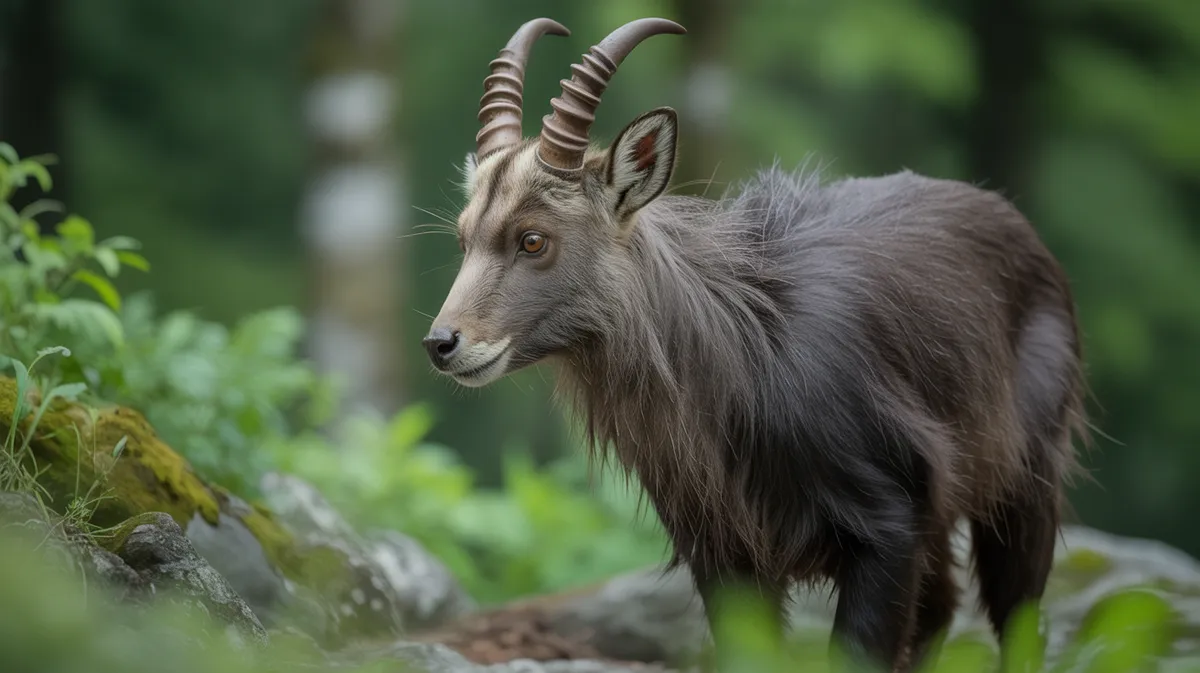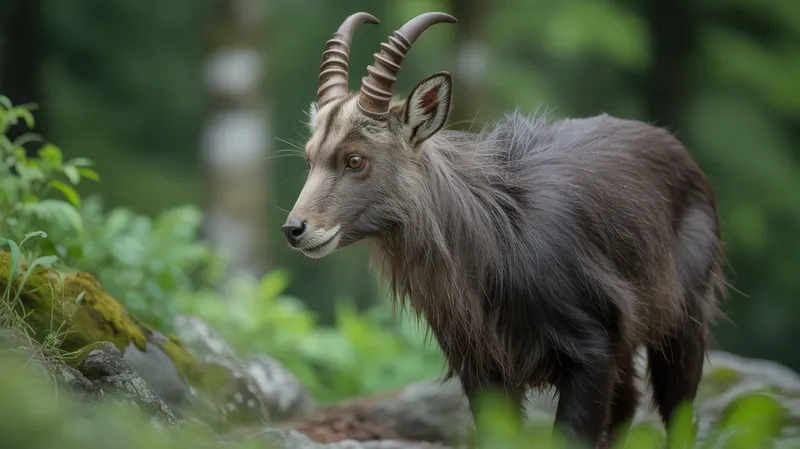
Japanese Serow
Capricornis crispus

Meet the Japanese Serow
The Japanese serow is a goat-antelope native to the dense woodlands and mountainous regions of Japan. It is characterized by its thick, woolly coat that varies from black to whitish gray, short backward-curved horns, and a sturdy, compact build adapted for steep terrain. The serow is a solitary and territorial animal, often seen browsing on leaves, shoots, and acorns in its forest home. Protected as a national symbol of wildlife, it plays an important ecological role in Japan's forested mountains.
Classification
Mammal
Habitat
Mountain forests
Diet
Herbivore
Lifespan
10-15 years
Conservation
Least Concern
Weight
30-45 kg
📖Fascinating Facts
Forest Dweller
Japanese serows are most commonly found in dense, mountainous forests, where they prefer steep, rocky terrain for both feeding and evading predators.
Horned Animals
Unlike true goats, both male and female Japanese serows possess small, backward-curving horns that continue to grow throughout their lives.
National Symbol
The Japanese serow holds special cultural importance in Japan and has been protected by law as a 'Special Natural Monument' since 1955.
📋Detailed Description
The Japanese serow (Capricornis crispus) is a medium-sized, robust caprid endemic to the mountainous forests of Japan, primarily Honshu, with smaller populations on Shikoku and, historically, Kyushu. Adults typically stand 70–90 cm at the shoulder and weigh between 30–45 kg, with males and females similar in size. Their dense, woolly pelage ranges from black and dark brown to pale gray or whitish, providing camouflage against the forested and often snowy landscapes. Both sexes possess short, backward-curving horns (10–15 cm), which are used in territorial disputes and defense. The serow has a stocky build, strong limbs, and specialized hooves with well-developed dewclaws, allowing agile navigation of steep, rocky terrain. Its face is marked by a distinctive white patch on the throat and dark facial stripes. Japanese serows are primarily solitary and highly territorial, using scent glands beneath the eyes to mark their home ranges. They are crepuscular, being most active at dawn and dusk, and display a cautious, elusive demeanor. The species is long-lived for a wild ungulate, with individuals reaching up to 20 years in protected environments.
💡 Did you know?
Despite their goat-like appearance, Japanese serows are more closely related to antelopes and are one of only a few goat-antelope species in the world.
🔬Research & Sources
Wikipedia Summary
The Japanese serow is a Japanese goat-antelope, an even-toed ungulate. It is found in dense woodland in Japan, primarily in northern and central Honshu. The serow is seen as a national symbol of Japan, and is subject to protection in conservation areas.
Last Modified: 3/20/2025
🎭Behavior & Social Structure
Japanese serows are predominantly solitary, though pairs or small family groups may be observed during the breeding season or when a mother is accompanied by her offspring. Each individual maintains a defined territory, typically 10–15 hectares, which it marks with secretions from preorbital glands. They are browsers, feeding on a variety of leaves, shoots, acorns, and occasionally bark, favoring broadleaf and coniferous understory plants. Foraging occurs mainly during twilight hours, with resting periods in dense cover during midday. Serows are highly vigilant, relying on acute hearing and olfaction to detect predators such as wolves (historically), wild dogs, and humans. When threatened, they emit a sharp, whistling alarm call and may flee to steep, inaccessible slopes. Aggressive encounters between adults, especially males, involve horn clashing and posturing but rarely result in serious injury.
👶Reproduction & Life Cycle
The breeding season for Japanese serows occurs from September to November. During this period, males expand their ranges in search of receptive females, engaging in ritualized displays and occasional combat. After successful mating, females undergo a gestation period of approximately 210–220 days, giving birth to a single kid (rarely twins) between May and June. Newborns are precocial, able to stand and follow their mothers within hours. Maternal care is intensive, with the mother hiding her kid in dense vegetation for the first few weeks to avoid predation. Weaning occurs at around 6 months, but juveniles may remain within the mother's territory for up to a year. Sexual maturity is reached at 2–3 years of age.
🛡️Adaptations & Survival
The Japanese serow exhibits several adaptations to its mountainous, forested habitat. Its dense, insulating coat protects against cold and wet conditions, while the coloration provides effective camouflage. The species' compact body and powerful limbs, combined with flexible joints and specialized hooves, enable agile movement on steep, rocky slopes and through dense undergrowth. The preorbital scent glands facilitate complex territorial marking and communication. Behavioral adaptations include crepuscular activity patterns to avoid both predators and human disturbance, and a solitary lifestyle that reduces competition for limited food resources. Their broad diet allows them to exploit a wide range of plant species, contributing to their resilience in variable environments.
📚Research Sources
🎨Cultural Significance
The Japanese serow holds significant cultural value as a national symbol of wildlife conservation and natural heritage. It is featured in Japanese folklore and art, often representing resilience and the spirit of the mountains. The species' recovery is regarded as a conservation success story, and it is protected in numerous national parks and reserves. Historically, serow products were used in traditional medicine and as a source of meat and hides, but such practices have largely ceased due to legal protection and changing societal values.
🔬Recent Research & Discoveries
Recent research has focused on the serow's ecological role as a keystone browser, influencing forest regeneration and plant community dynamics. Genetic studies have clarified its taxonomic status within the genus Capricornis and revealed low genetic diversity, likely due to historical population bottlenecks. Ongoing studies are investigating the impacts of climate change and human encroachment on serow distribution and behavior. Non-invasive monitoring techniques, such as camera trapping and genetic sampling from feces, are increasingly used to assess population trends and health. There is also interest in the species' potential as an indicator for ecosystem health in Japanese mountain forests.
🎥Wildlife Videos

Japan´s Wild North: The Wilderness of Hokkaido | 4K UHD Documentary
"Gift from the Ice - Japan's Wild North" offers an immersive exploration of Hokkaido, Japan's northernmost island.
space and science

Meet the Japanese Serow (Kamoshika)
Welcome back to a new episode of Familiarity with Animals, where we introduce you to the incredible creatures that inhabit our ...
Familiarity With Animals (FWA)

Japanese Serow: A Dance With the Ages #JapaneseSerow #AncientDance #MountainMystery #Wildlife 🍃🇯🇵
"Japanese Serow: A Dance With the Ages " Step into the misty mountains of Japan and discover the enchanting world of the ...
The Ethical Wild

Wildest Islands | Japan - Islands of Extremes | Free Documentary Nature
Wildest Islands | Episode 1: Japan - Islands of Extremes | Wildlife Documentary Watch 'Wildest Islands - Episode 2' here: ...
Free Documentary - Nature

Day 28 Mysterious Animal | Japanese Serow — This 'Cute' Animal is a DEADLY Mountain Phantom
The Japanese Serow is one of the most aggressive and territorial beasts in the mountains of Japan. With razor-sharp horns, ...
Nature is Calling

Discovering the Secret World of the Japanese Serow
Explore the fascinating life of the lesser-known Japanese Serow, unveiling its unique traits and debunking common ...
Animal Unknown - Adam
🌍Habitat Information
The Japanese Serow typically inhabits Mountain forests environments. Japanese Serows have adapted to their environments with specialized features and behaviors.
Primary Habitat:
Mountain forests
More detailed habitat information will be available soon.
🛡️Conservation Status
The Japanese Serow is currently classified as Least Concern. Conservation efforts are crucial for preserving this species for future generations.
Common Threats:
- 🏠Habitat loss and fragmentation
- 🌡️Climate change impacts
- 🎯Hunting and poaching
- 🏭Human-wildlife conflict
⚠️Threats & Conservation Challenges
Historically, Japanese serow populations declined due to overhunting for meat, hides, and traditional medicine, as well as habitat loss from logging and development. Legal protection since the 1950s, including designation as a 'Special Natural Monument,' has enabled population recovery, with current estimates exceeding 100,000 individuals. However, localized threats persist, including habitat fragmentation, vehicle collisions, and occasional illegal poaching. In some regions, serows are perceived as agricultural pests due to crop raiding, leading to conflict with farmers and calls for population control. Climate change poses a potential long-term threat by altering forest composition and snow cover patterns.
🔬Scientific Classification
Scientific Name
Capricornis crispus
Classification Hierarchy
🔍 About Taxonomic Classification
Taxonomic classification is a hierarchical system used by scientists to classify and organize living organisms based on shared characteristics and evolutionary relationships.
The system moves from broad categories (Kingdom) to increasingly specific ones, with each animal's scientific name typically consisting of its Genus and species.
📝Community Notes
Share your observations and insights about the Japanese Serow with our community of wildlife enthusiasts.
Join Our Community
Sign in to share your observations and connect with fellow wildlife enthusiasts.
Sign In to ContributeNo community notes yet
Be the first to share your observations about the Japanese Serow!
Explore Japanese Serow
Select a tab above to learn more about this amazing animal.
📸Photo Gallery
No photos available for this animal yet.
🌟Discover More Wildlife
Continue your journey of discovery with more fascinating animals from our database
